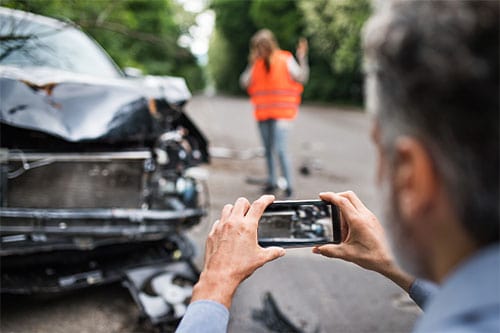In the first painful minutes after a car accident, it’s easy to feel overwhelmed. There’s so much that has to be done, seemingly all at the same time: checking with all parties involved for injuries, assessing damage to the vehicles, moving to safety, summoning police, exchanging information and contacting insurance companies.
With so much on their plate, it’s not surprising that many drivers forget to take one additional step before leaving the accident scene: taking photos to document what happened.
Snapping pix may be the last thing on your mind in the aftermath of a crash, but it can prove tremendously useful down the line, helping you as you seek compensation for your damages and resolving disputes about the circumstances of the accident.
WHAT KIND OF CAMERA SHOULD I USE?
You don’t need a fancy digital camera stored in your glove compartment for just such unhappy occasions as this one. (Although, if you do have one on hand, more power to you.) The same cell phone you’re using to call 911 and your insurance agent probably has a camera with flash that will do the job just fine.
Take more pictures than you think you’ll need, with flash and without, from different distances.
Hold the camera (or your phone) steady to avoid blurring your work.
Zoom in for detail and go wide to provide context. If necessary, use some familiar object, such as car keys or a glove, in close-up shots to give a sense of scale to what the photo depicts. If there is a time and date stamp function for your camera, make sure it’s enabled and accurate before you begin.
WHAT TO PHOTOGRAPH?
The short answer to this question, of course, is everything that provides relevant visual evidence of the accident and the damages involved.
The essentials include any injuries suffered by you, your passengers, or other parties involved, if possible; damage to your vehicle and other vehicles; and debris left by the accident, such as shattered glass or vehicle trim on the roadway.
But don’t stop there.
Assuming conditions around the accident site are safe and you are not in urgent need of medical care, you should take pictures of any skid marks, nearby traffic signs and signals, weather conditions (such as an icy roadway) or other hazards that may have played a part, and other property damage that may have occurred, including photos of the interior of your car and its contents if relevant.
Other photos that can help document the scene include snaps of the license plates of all vehicles involved, images of witnesses and other parties involved, and the other motorist’s driver license and insurance documents.
This may seem like overkill, but keep in mind that photographs provide a visual record that’s difficult to challenge. If nothing else, the photos can serve as a memory aid as you pursue an insurance claim — but they can also be powerful evidence in their own right, substantiating your injuries or helping to show how the accident occurred.
THE CAR ACCIDENT LAWYERS AT FDAZAR
For more than thirty years the car accident attorneys at Frank Azar Car & Truck Accident Lawyers have helped thousands of injured people obtain complete and timely compensation for their losses. Our proven track record and expertise have allowed us to grow into the largest personal-injury law firm in Colorado, with offices in Denver, Aurora, Thornton, Fort Collins, Greeley, Grand Junction, Colorado Springs, and Pueblo. If you’ve been injured in a car, truck, or motorcycle accident, you may be entitled to compensation. Please call the car accident attorneys at FDAzar day or night at 720-372-2824 or contact us here for a free consultation and no-obligation evaluation of your case.

